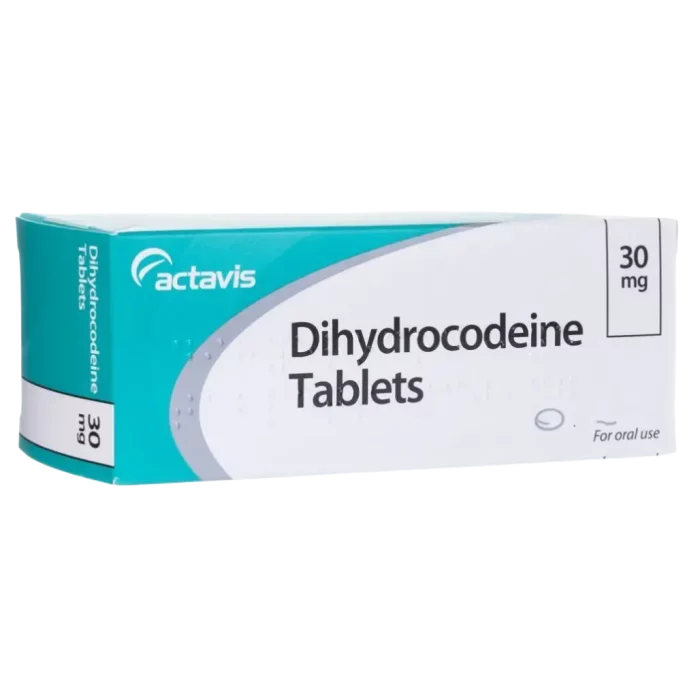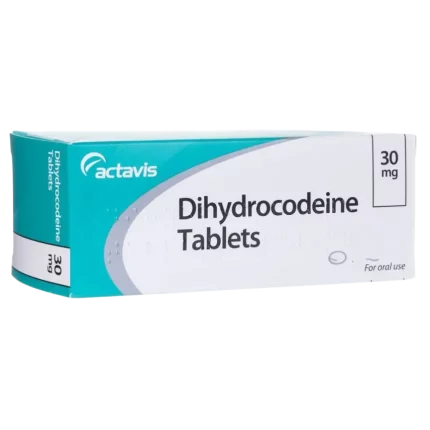Dihydrocodeine 30 mg
-
Onset: 30–60 minutes after oral intake
-
Duration: 4–6 hours of pain relief
-
Each tablet contains 30mg Dihydrocodeine
-
Brand: Accord 30 mg
-
Prescribed for moderate to severe pain
| Brand |
Accord (30mg) |
|---|---|
| Strength |
30 mg |
| Dosage Form |
Tablet |
| Active Ingredient |
Dihydrocodeine |
£52.50
| Package Size |
30 Tablets |
|---|
-
Onset: 30–60 minutes after oral intake
-
Duration: 4–6 hours of pain relief
-
Each tablet contains 30mg Dihydrocodeine
-
Brand: Accord 30 mg
-
Prescribed for moderate to severe pain
| Brand |
Accord (30mg) |
|---|---|
| Strength |
30 mg |
| Dosage Form |
Tablet |
| Active Ingredient |
Dihydrocodeine |
| Package Size |
30 Tablets |

Discreet UK, Ireland & EU delivery

Safe and Discreet Payments
Dihydrocodeine 30 mg is a prescription pain reliever that steps in when regular painkillers just are not cutting it. We are talking about moderate to severe pain that keeps breaking through paracetamol or anti inflammatory medicines and starts getting in the way of normal life. This is a fast acting option for people dealing with pain that does not settle with basic treatment, and understanding what it is, how it works, and how it is usually taken can make a real difference in how safely and effectively it is used.
What is Dihydrocodeine?
Dihydrocodeine is a semi synthetic opioid pain medicine used to manage moderate to severe pain. It is part of the opioid family, which means it works on the body’s built in pain control system rather than just calming swelling or reducing fever.
It is often prescribed when first line options like paracetamol or anti inflammatory drugs have not given enough relief and you need something stronger and more targeted.
The 30 mg strength is one of the commonly prescribed tablet doses for adults. It offers a clear, measured starting point for prescription pain control, especially in situations like post injury or post procedure pain. Therefore, this dosage is often recommended if you want to buy Dihydrocodeine.
How Dihydrocodeine works
Dihydrocodeine works by attaching to specific receptors in the brain and spinal cord called mu opioid receptors. When it does that, it helps block or reduce the pain signals being sent through the nervous system. You still know something hurts, but it does not feel as sharp, as loud, or as constant.
By changing the way your body processes pain, it can lower the intensity and make it easier to rest, move, and recover.
Because it is an opioid, you may also notice effects like sleepiness or a floaty sense of calm along with the pain relief. This is normal for this type of medicine, but it is also the reason opioids have to be treated with respect and not taken casually.
Dihydrocodeine 30 mg dosage
Always follow the exact instructions on your prescription, as dosing can be different from person to person based on your condition, other medicines, and how you respond to opioids. The information below is a general guide only.
For adults and young people aged 12 and up, the usual dose of a standard 30 mg tablet is one tablet every 4 to 6 hours as needed for pain.
There is also a daily limit. The typical maximum for the standard 30 mg tablets is six tablets in 24 hours, which adds up to 180 mg total in a day unless you have specifically been told otherwise. Going past that increases the risk of serious side effects.
The goal is always the lowest dose that actually helps, and only for as long as you truly need it. This is not something you stay on casually long term.
Some versions of dihydrocodeine are slow release instead of immediate release. Slow release tablets are designed to last longer in the body, so they are not taken as often. If you have been given an extended release form, the timing and instructions will be different.
How to take Dihydrocodeine
Swallow the tablet with water, ideally after food, unless you were told otherwise. Do not crush or chew it unless it is specifically a chewable or dispersible version.
Take it when the pain becomes significant instead of letting the pain get so severe that you are already exhausted by it. If previous doses have helped you, staying on a steady rhythm can sometimes keep the pain from spiking too high between doses.
Because drowsiness or dizziness can happen, make sure you are in a situation where it is safe to slow down if you start to feel sleepy. Avoid driving or using heavy machinery until you know exactly how your body reacts to it.
Do not take more than the number of tablets you were told to take in a 24 hour period. If you miss a dose and the pain comes back, just take the next scheduled dose. Do not double up to catch up.
Dihydrocodeine 30 mg Side effects
Like any opioid pain medicine, Dihydrocodeine can cause side effects. Some are fairly common and more annoying than dangerous. Others are less common but need quick attention.
Common side effects
Feeling sleepy or drowsy
Constipation
Feeling sick or being sick
Feeling dizzy or light headed
Dry mouth or headache
Less common but more serious effects
Slow or shallow breathing
Confusion, blurred vision, or fainting
Serious allergic reactions like swelling or an intense rash
Signs of dependence or withdrawal if it is used for a long time
The chances of side effects go up if the dose is too high or if it is taken with alcohol or other sedating medicines.
Warning
Dihydrocodeine 30 mg is a prescription only opioid painkiller and it should be handled with care.
Do not drive or use machinery after taking it until you know exactly how it affects your concentration and reaction speed.
Do not mix it with alcohol, sleeping tablets, anxiety medication, or other opioids. That kind of combination can lead to trouble breathing, heavy drowsiness, or blacking out.
Keep the tablets somewhere safe, out of reach of children, and do not share them with anyone else. Even if someone says they have the same kind of pain, this medicine is not a general pain tablet.
Dihydrocodeine is meant for short term pain relief. Longer or repeated use can lead to tolerance, dependence, or withdrawal type symptoms when stopping.
If you notice serious side effects such as trouble breathing, sudden confusion, or chest related problems, treat that as urgent.
Is Dihydrocodeine a strong painkiller
Yes. Dihydrocodeine is considered a strong pain reliever compared with standard over the counter options. It is usually brought in when moderate to severe pain is still breaking through medicines like paracetamol or ibuprofen.
Benefits of Dihydrocodeine and how it feels
It can provide fast and effective relief from moderate to severe pain
It can dial down pain intensity so normal daily tasks feel possible again
It can make movement and basic mobility easier during recovery after an injury or procedure
It can interrupt that stress, pain, tension cycle that wears you down physically and mentally
How it may feel
A lot of people notice the pain start to settle not too long after taking a dose. The relief often comes with a sense of calm or a softer, quieter body. You might feel slightly sleepy or less alert than usual, so it works best in moments when you can slow down, rest, and let the body recover.
How long does Dihydrocodeine 30 mg last?
With standard oral tablets, most people start to feel the effect about 1 to 2 hours after taking a dose. The main pain relief usually lasts for roughly 4 to 6 hours. After that, the effect starts to fade, although your body may still be processing it in the background.
For example, if someone takes a tablet at 8 PM, they may feel solid relief through late evening and into around midnight. After that, the stronger effect eases off, and whatever is left tends to wear away gradually toward early morning.
Can I drive on Dihydrocodeine?
Driving on Dihydrocodeine needs caution. This is an opioid, which means it can cause things like
- Feeling sleepy or drowsy
- Slower reaction time
- Feeling dizzy or light headed
If you notice any of that after a dose, you should not drive or use machinery. A safer approach is to see how your body reacts in a relaxed setting first, instead of finding out on the road.
Dihydrocodeine vs Codeine, what is the difference?
Dihydrocodeine is a semi synthetic opioid that sits in the same family as codeine, but it is generally stronger and gives a more powerful level of pain relief.
Codeine needs to be converted by the body into other active forms, including a small amount of morphine, before you feel the full effect. Dihydrocodeine acts more directly, so it does not rely as much on that conversion step.
Because Dihydrocodeine is more potent, it can also carry a higher risk of side effects and dependence compared with codeine.
So even though both are used for pain, they are not the same. They differ in strength, how they work in the body, and the level of care needed when using them.
Buy Dihydrocodeine 30 mg Online UK & Europe
Looking to buy Dihydrocodeine 30 mg online? At Medicine4Me, you can order this effective pain-relief medication safely, discreetly, and conveniently from your home. Dihydrocodeine 30 mg is commonly used to manage moderate to severe pain, providing quick and reliable relief for conditions such as injury, post-surgery discomfort, or chronic pain.
When you order from us, you can expect:
- High-quality, genuine medication, All Dihydrocodeine 30 mg tablets are sourced from trusted pharmaceutical manufacturers.
- Discreet and secure packaging, Every order is shipped in plain, unmarked packaging to ensure your privacy.
- Fast, reliable delivery, Receive your order quickly, only within a few days, with tracking available for peace of mind.
- 24/7 customer support, Our team is always available to answer your questions and provide guidance for safe and responsible use.
Whether you need Dihydrocodeine 30 mg for ongoing pain management or temporary relief, ordering online from Medicine4Me is simple, safe, and fully confidential.
💡 Tip: Always ensure you purchase from a trusted online pharmacy to avoid counterfeit products and guarantee quality.
Dihydrocodeine 30 mg is prescribed for short term relief of moderate to severe pain when normal painkillers like paracetamol or ibuprofen are not doing enough. You’ll often see it used for things like post surgery pain, dental work, an injury, or recovery after something that left you sore and struggling to sleep or move comfortably.
Yes, it is. Dihydrocodeine is considered a strong painkiller compared to the usual over the counter options. It is part of the opioid group, which means it does not just fight inflammation, it actually changes the way your body senses and responds to pain.
A standard immediate release 30 mg tablet usually starts working fairly quickly and can keep pain down for a few hours at a time. There are also slow release versions that are designed to last longer in the body, so you do not have to take them as often. Follow the schedule you were given, because timing can change depending on which version you have.
For adults, a common dose is one 30 mg tablet every 4 to 6 hours when needed for pain. But your exact timing and total amount should match what you were told, not what someone else takes. Swallow the tablet with water. Do not crush or chew slow release tablets. Never go over the maximum daily amount on your prescription, even if the pain is still there.
Be very careful here. Dihydrocodeine can make you sleepy, slow your reaction time, blur your vision, and make you feel light headed. You should not drive, use machinery, or do anything that needs fast thinking and fast hands until you know exactly how your body reacts to it. Driving while woozy is not just unsafe, it can also get you in trouble.
Some of the common ones include feeling drowsy, constipation, feeling sick or being sick, dry mouth, feeling light headed, or a headache. These effects are more likely if you’re also taking other things that make you sleepy, or if you drink alcohol. If side effects don’t settle or feel too strong, get advice instead of just pushing through it.
You should treat it as urgent if you notice very slow or shallow breathing, extreme drowsiness, not being able to stay awake, sudden confusion, fainting, or signs of an allergic reaction like swelling or a severe rash. Those can be signs of serious opioid effects and they need attention right away.
Dihydrocodeine is an opioid, and like other opioids it can lead to dependence and withdrawal if it is taken longer than intended, taken too often, or taken in higher amounts than prescribed. That is why it is important not to use it more often than directed, and not to give it to someone else. If you ever feel like you are starting to rely on it just to feel normal, that is something to take seriously.
No. Alcohol and Dihydrocodeine do not mix. Drinking while on Dihydrocodeine can make you dangerously sleepy, slow your breathing, and increase the risk of overdose type reactions. The same warning goes for other sedating medicines like sleeping tablets or certain anxiety medicines.
Specification
 Overview
Overview
| Brand |
Accord (30mg) |
|---|---|
| Strength |
30 mg |
| Dosage Form |
Tablet |
| Active Ingredient |
Dihydrocodeine |
| Package Size |
30 Tablets |


















Reviews
Clear filtersThere are no reviews yet.